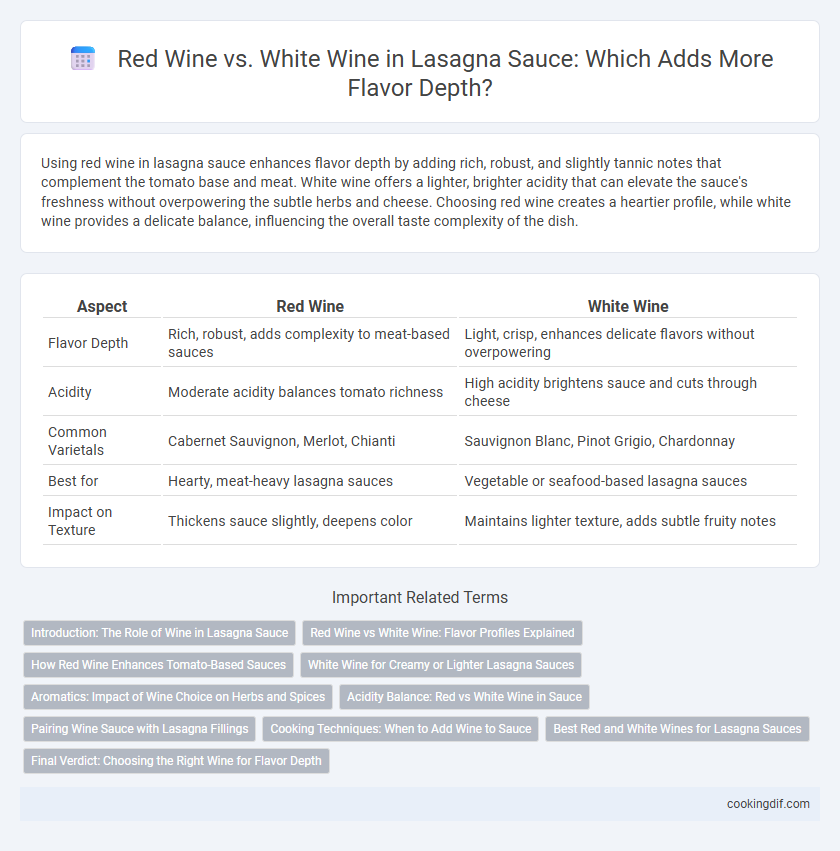Using red wine in lasagna sauce enhances flavor depth by adding rich, robust, and slightly tannic notes that complement the tomato base and meat. White wine offers a lighter, brighter acidity that can elevate the sauce's freshness without overpowering the subtle herbs and cheese. Choosing red wine creates a heartier profile, while white wine provides a delicate balance, influencing the overall taste complexity of the dish.
Table of Comparison
| Aspect | Red Wine | White Wine |
|---|---|---|
| Flavor Depth | Rich, robust, adds complexity to meat-based sauces | Light, crisp, enhances delicate flavors without overpowering |
| Acidity | Moderate acidity balances tomato richness | High acidity brightens sauce and cuts through cheese |
| Common Varietals | Cabernet Sauvignon, Merlot, Chianti | Sauvignon Blanc, Pinot Grigio, Chardonnay |
| Best for | Hearty, meat-heavy lasagna sauces | Vegetable or seafood-based lasagna sauces |
| Impact on Texture | Thickens sauce slightly, deepens color | Maintains lighter texture, adds subtle fruity notes |
Introduction: The Role of Wine in Lasagna Sauce
In lasagna sauce, red wine enhances flavor depth by adding rich, robust notes from tannins and dark fruit, complementing tomato-based sauces. White wine contributes a subtle acidity and lightness that brightens the sauce without overpowering delicate herbs and cheeses. Choosing red or white wine influences the overall taste profile, balancing savory, sweet, and acidic elements to elevate the dish.
Red Wine vs White Wine: Flavor Profiles Explained
Red wine in lasagna sauce imparts bold, rich flavors with deep tannins and fruity undertones, enhancing the meatiness and complexity of the dish. White wine offers a lighter, more acidic profile, brightening tomato-based sauces and adding subtle floral and citrus notes without overpowering other ingredients. Choosing red wine emphasizes robust depth, while white wine provides a more delicate, vibrant flavor balance in traditional lasagna recipes.
How Red Wine Enhances Tomato-Based Sauces
Red wine enhances tomato-based lasagna sauces by intensifying the rich, robust flavors through its tannins and complex fruity notes, which complement the acidity of tomatoes. The deep color and bold profile of red wine create a more savory and layered sauce compared to white wine, which tends to impart a lighter, fruitier character. This flavor depth from red wine results in a fuller-bodied sauce that elevates the overall taste and aroma of the lasagna.
White Wine for Creamy or Lighter Lasagna Sauces
White wine enhances creamy or lighter lasagna sauces by imparting subtle acidity and delicate fruity notes that brighten the overall flavor profile without overpowering the dish. Its crispness complements ingredients like bechamel or ricotta, creating a balanced and harmonious taste. Conversely, red wine often dominates with richer, bolder tannins better suited for robust tomato-based sauces, making white wine the preferred choice for maintaining flavor depth in lighter variations.
Aromatics: Impact of Wine Choice on Herbs and Spices
Red wine intensifies lasagna's herbaceous and spicy notes, enhancing aromatics like rosemary, thyme, and black pepper with its robust tannins and deep berry flavors. White wine imparts a lighter, more citrus-driven brightness that elevates delicate herbs such as basil, oregano, and parsley, providing a fresh and zesty aroma. Selecting red or white wine directly affects the aromatic profile, shaping the balance and depth of the sauce's herbal complexity.
Acidity Balance: Red vs White Wine in Sauce
Red wine enhances lasagna sauce with robust tannins and rich fruitiness, creating a deeper, more intense flavor profile while adding moderate acidity that balances tomato sweetness. White wine contributes a lighter, crisper acidity, brightening the sauce and emphasizing fresher, citrusy notes without overpowering the dish. Choosing between red and white wine in lasagna sauce depends on desired acidity balance--red for depth and smoothness, white for brightness and sharpness.
Pairing Wine Sauce with Lasagna Fillings
Red wine sauce enhances lasagna with rich, robust flavors that complement beef or lamb fillings, adding depth through tannins and dark fruit notes. White wine sauce offers a lighter, slightly acidic profile ideal for chicken or vegetable fillings, enhancing freshness and subtlety in the dish. Pairing the wine sauce with the specific lasagna filling balances the overall flavor, elevating the taste experience by matching intensity and texture.
Cooking Techniques: When to Add Wine to Sauce
Adding red wine early in the lasagna sauce simmering process enhances flavor depth by allowing tannins to mellow and integrate with tomato and meat elements. White wine, added towards the end of cooking, preserves acidity and brightens the sauce, creating a lighter complement to creamy bechamel layers. Timing wine addition is crucial; prolonged cooking with red wine builds robust complexity, while brief simmering with white wine maintains vibrant, fresh notes.
Best Red and White Wines for Lasagna Sauces
Red wine enhances lasagna sauce with rich tannins and fruity notes, making Cabernet Sauvignon and Chianti ideal for deep, robust flavors. White wine offers a lighter, acidic brightness that complements creamy bechamel sauces, with Pinot Grigio and Sauvignon Blanc being the best choices for subtle complexity. Selecting the right wine based on the sauce type intensifies the overall taste experience, balancing acidity and texture perfectly.
Final Verdict: Choosing the Right Wine for Flavor Depth
Red wine enhances lasagna sauce with robust tannins and deep berry flavors, creating a rich, complex profile that complements the meat and tomato base. White wine adds brightness and acidity, offering a lighter, slightly fruity note that balances creamy cheese elements without overpowering. For maximum flavor depth, red wine is preferred in traditional meat sauces, while white wine suits vegetable or seafood lasagnas seeking a fresher taste.
Red wine vs White wine in sauce for flavor depth Infographic

 cookingdif.com
cookingdif.com